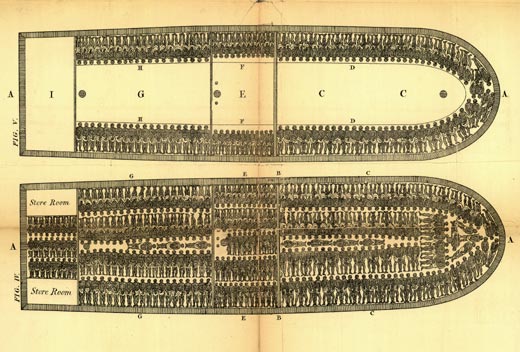
The Birmingham Anti-Slavery Society
The Men’s Campaigns
Later Histories and Connections
Directions for Learning
The Birmingham Anti-Slavery Society
Images of African slave trade vessels inhumanly over-crowded with
people destined for plantations in America, the West Indies, Cuba
and Brazil provoked moral outrage in Birmingham. Formed 1826 in
resistance to the traffic in human beings, the 'Birmingham Anti-Slavery
Society' became a local, national and international campaign group
which took an important role in petitioning for nineteenth century
antislavery laws.
Joseph Sturge was a key member of the group, serving throughout
his life as one of its most impassioned leaders. Other members were
men of predominantly middle class backgrounds belonging to various
professions, churches, businesses, civic societies, town improvement
boards and medical professions. These included people such as Richard
Cadbury (the chocolate maker), Charles Lloyd (an important banker),
Rev. John Angel James (of Carrs Lane Church), Rev. Thomas Swan (of
Canon Street Chapel) and William Morgan (later Birmingham’s
Town Clerk).
The 'Birmingham Anti-Slavery Society' was dependant upon private
and public donations to survive, which meant it drew people of great
personal commitment to the cause, able to donate time, money and
effort outside of their own personal and working lives. Many of
its members were also involved with other reform societies, such
as ‘The Complete Suffrage Union’ (where Sturge backed
working class rights) and the ‘Baptist Missionary Society’
(promoting religious education in the colonies).
After the emancipation of the West Indies in 1838, the society
would became known as the Birmingham branch of the ‘British
and Foreign Anti Slavery Society’. This new name signified
a change of focus. Once slavery had been abolished in the British
Colonies, the Birmingham society now sought to combat the ongoing
existence of slavery in other nations, especially in America.
<return to top>
The Men’s Campaigns
The society grew from a relatively small local organisation in
1826 to play a major role in antislavery politics. It became particularly
renown for its role in calling for the end of the West Indies ‘apprenticeship’
system in 1837/38. At this time, being an ‘apprentice’
meant being a slave in all except name. To prove this point, Sturge
went on an extraordinary personal journey on behalf of the 'Birmingham
Anti-Slavery Society' to visit the area and uncover first hand evidence
for the true conditions of the people. His book A Visit to the West
Indies in 1837 is evidence of Birmingham’s central involvement
in bringing about the August 1st 1838 Emancipation Act.
Throughout its history, the 'Birmingham Anti-Slavery Society' established
cultural and political connections that drew Birmingham into contact
with activists and campaigners for social justice from around the
world. Two important examples of these contacts include Frederick
Douglass, the inspiring black intellectual who had personally escaped
slavery, and Harriet Beecher Stowe, author of the celebrated antislavery
novel 'Uncle Tom’s Cabin'. Having visited the West Indies
in 1837, Sturge was also no stranger to America. He later crossed
the Atlantic once again to write another antislavery travel narrative
entitled, 'A Visit to the United States in 1841'.
The overall outlook of Sturge’s antislavery society reflected
a mixture of radical possibilities set within conservative limitations.
It could be argued that some of the society may have acted more
from a belief that white civilized society needed to be freed from
the ‘sin’ of slavery, rather than from a sense of equality
with the African slave. At the same time, their expressed belief
in a ‘universal brotherhood of man’ threatened traditional
ideas about society, race and class. Spreading this belief in a
town which had profited from the ‘African trade’ was
an uphill battle; and their unorthodox views of religion often meant
the campaigners were dismissed as idealistic. For black abolitionists
who had experienced the horrors of slavery, however, they were never
quite radical enough.
<return to top>
Later Histories and Connections
Once slavery had been abolished both in the British Colonies (1838)
and in America (1863), the Birmingham British and Foreign Antislavery
Society had to adapt to new circumstances in order to support those
that were still left at risk. Joseph Sturge passed away in 1859,
ending an important chapter in Birmingham’s history. Without
him, a number of new socities formed.
In 1864 a ‘Birmingham Freedmen’s Aid Society’
was active. This began to send donations of tools and practical
materials to the American South to help black people suffering from
poverty in the post-emancipation period to reconstruct their lives.
Even as late as 1873, the evidence shows that people from Birmingham
maintained a strong interest in helping the oppressed slave. A meeting
in the town hall was held, January 22nd, 1873, “To promote
the Suppression of Slave and Man Traffic in Africa and Polynesia,
and the Abolition of Slavery in Cuba”.
Birmingham’s antislavery societies were also an important
forefather of ‘Anti Slavery International’, the campaign
group still in operation today, combating contemporary issues such
as wage slavery, illegal child labour and discrimination against
women. It is, in many ways, a close descendent of those first societies
led by Sturge and others. An account of this connection can be found
on the home page of www.antislavery.org.
<return to top>
Directions for Learning
Starting points for further discussion, or your own archive research, might include:
How effectively did antislavery activists in Birmingham engage with people of different races and cultures?
How might the attempt of Joseph Sturge and The Birmingham Anti-Slavery Society to combat oppression be linked
to later anti-racist campaign groups in Birmingham, such as The Indian Workers Association?
<return to top>
Image Reference:
Local Studies and History: Slavery Pamphlet Coll. A326.08 Volume
E/1 (facsimile plate).
|